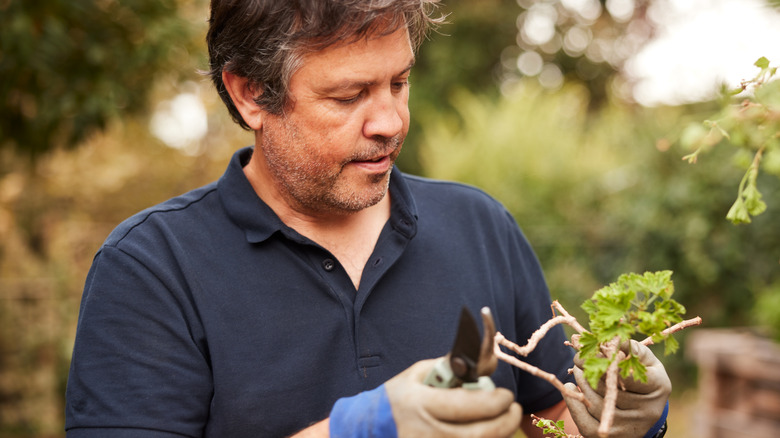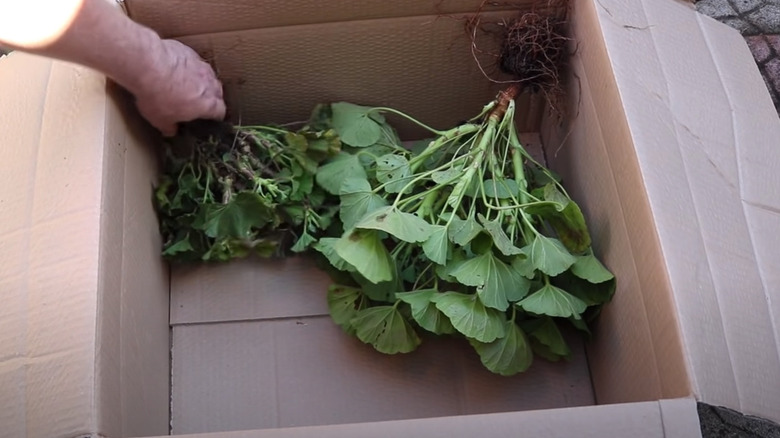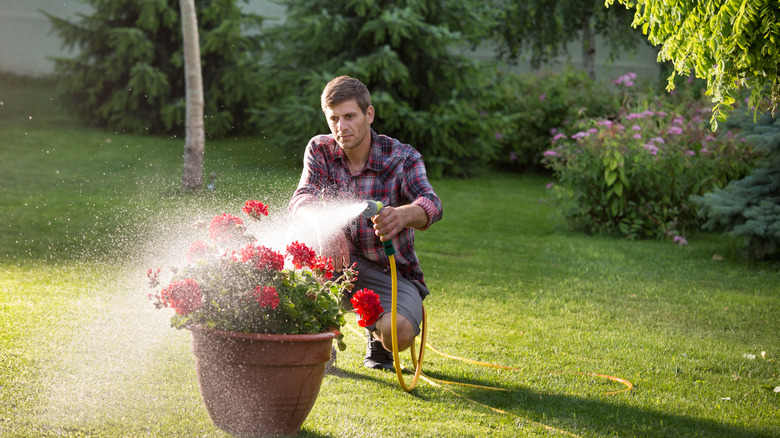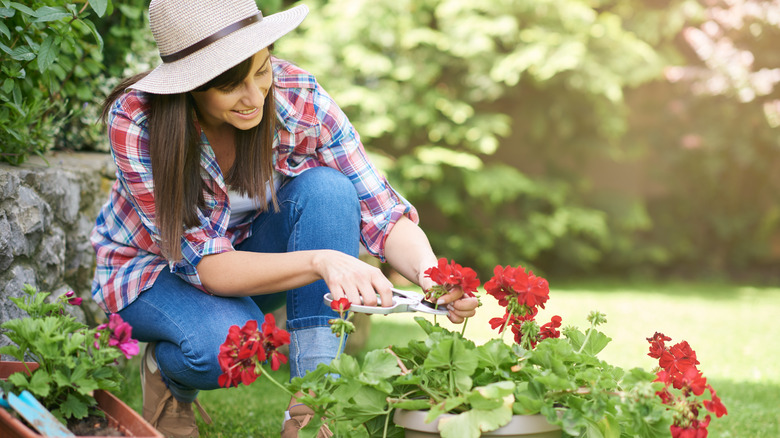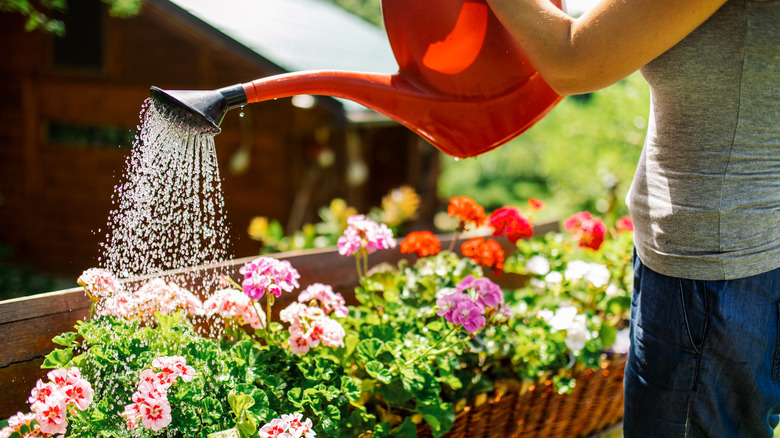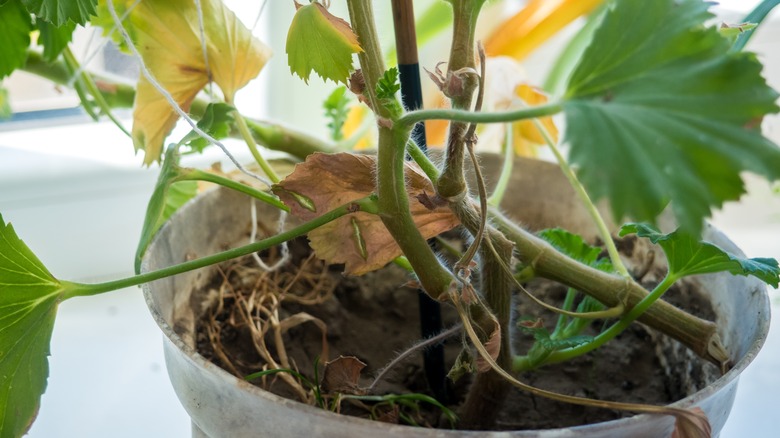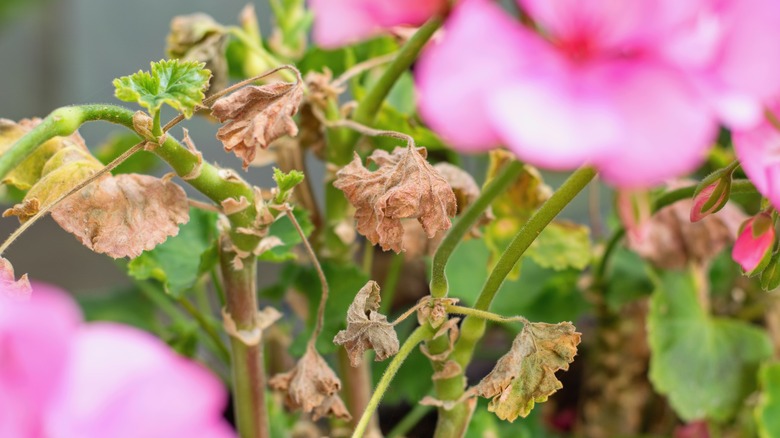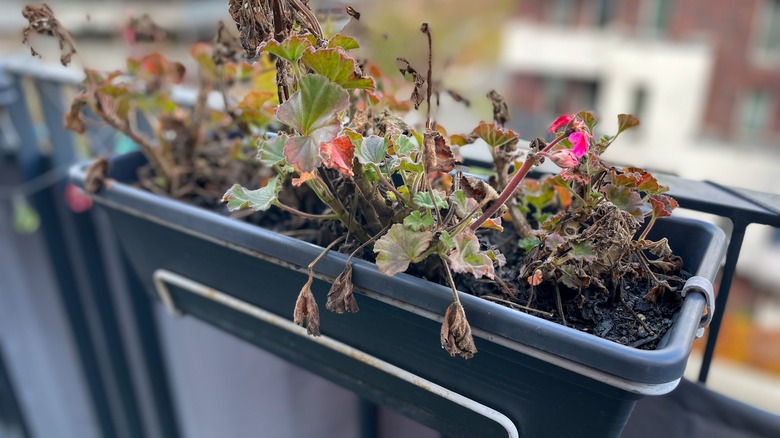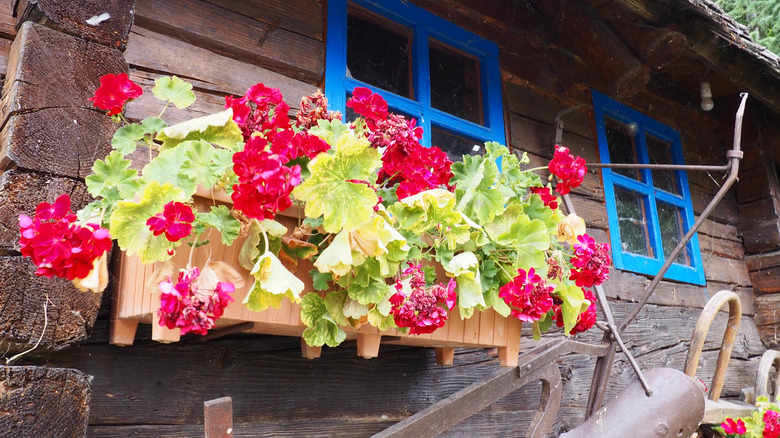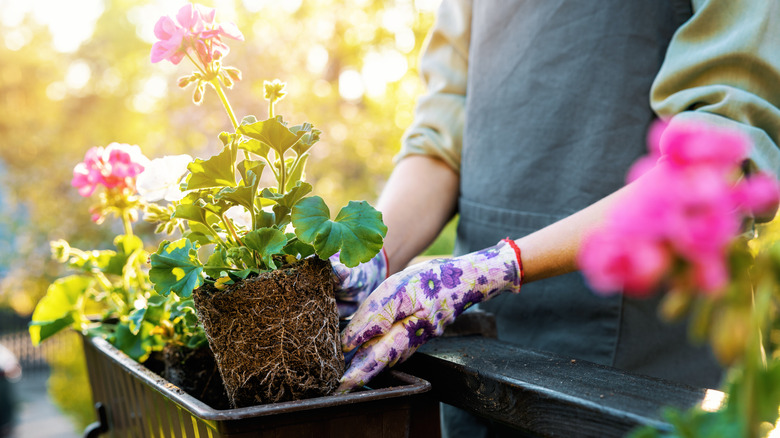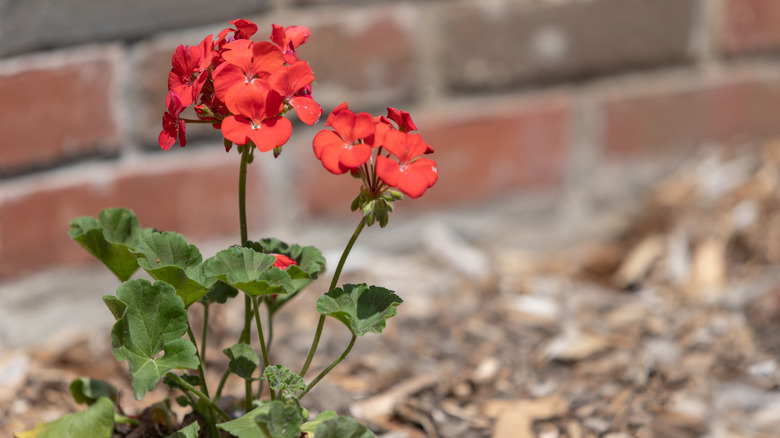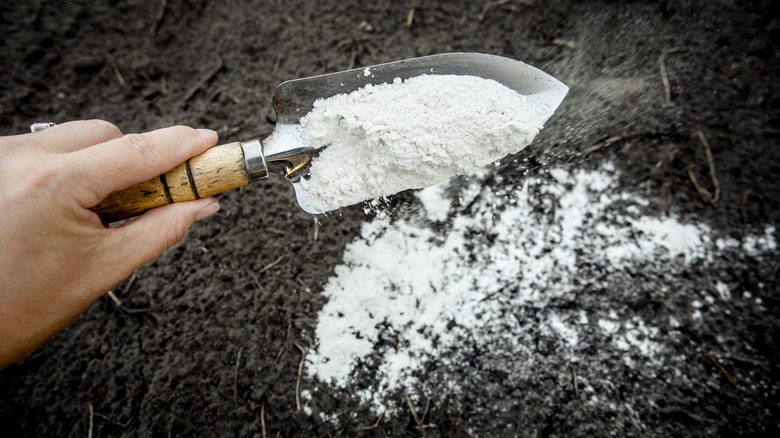11 Reasons Your Geraniums Are Dying (And How To Fix It)
Geraniums are grown all over the world and have been cultivated by gardeners for over 200 years. They do well planted in the ground, in pots, or hanging baskets. There are over 280 species to choose from, and you can take your pick from trailing types, beautiful bedding varieties, and bushy, scented specimens. But what really sets geraniums apart is their easy-to-care-for nature. This makes them a favorite with beginner plant parents as well as busy gardeners who don't have time to tinker over every flowering plant in their care.
Quick aside, what most hobby gardeners call geraniums are actually pelargoniums, so if you see the names used interchangeably, that's why. Both pelargoniums and true geraniums come from the same family of plants. Because of this, some planting advice applies to both species types.
Once established, common geraniums are relatively hardy plants that will reward you with a showy display of blooms, often lasting multiple months. They're resilient, virtually slug-proof, and non-fussy feeders. As they're generally low-maintenance, you can neglect them a little, and they won't take it too personally. But there are some things that geraniums don't tolerate well, which can leave them looking like they're on the verge of death. Fortunately, once you know what's ailing your pelargonium plants and can rectify the problem, they're usually quick to bounce back and start blooming. If your geraniums are dying and you can't figure out why, keep calm and read on to discover 11 potential causes.
You're leaving them out in the frost
Geraniums mostly originate from South Africa, which has a combination of sub-tropical, temperate, and Mediterranean climate zones. Certain pelargonium species also occur along the East African coast, in Madagascar, and as far north as India. Because of this, geraniums can tolerate a relatively broad range of temperatures. However, one thing that most of these climates don't have is frost. Prolonged icy conditions are the number one enemy of geraniums. Some can handle a light or occasional frost, but if you leave your plants out in the snow or expose them to a freeze, they're almost definitely done for.
Fortunately, there are various ways you can overwinter these African ornamentals. If your geraniums are in the ground, you can dig them up, prune off any leggy or dead growth, and plant into pots that you can place in a protected spot, such as a sunny porch. You can also take cuttings by snipping off a few inches of stem. Geraniums are generally happiest when temperatures are between 60 to 65 degrees Fahrenheit during the day and drop a bit below this at night. They also need six or more hours of direct sunlight per day. If you don't have a protected spot that will provide them with these requirements, you can also store them over winter as bare-root plants. Simply dig up the root ball, gently shake out the soil, and stow in a large paper bag or hang upside down, in a cool, dark, and dry location.
Their leaves are constantly wet
Geraniums aren't as sensitive to moisture on their leaves as species like African violets, but if their foliage is wetted too frequently, this can trigger and exacerbate bacterial diseases like Pseudomonas cichorii, P. syringae, and Botrytis cinerea, all commonly known as bacterial blight. Bacterial blight usually first shows up as either pale, yellow, or brown spots on the leaves. Botrytis blight causes gray, furry growths to develop. Because of this, it's also known as gray mold. After taking hold on wet leaves, the bacteria invades geraniums via their water-conducting tissues. This can eventually cause the whole plant to start drooping and wilting. Unfortunately, the first thing most plant owners do when they see drooping plants is to add more water, further wetting the leaves and helping the bacterial infection along. Ivy geraniums won't wilt but can instead start looking like they've been attacked by mites or are lacking in nutrients.
To avoid all of this, water your geraniums at the base of their stems, especially if you live in a damp, humid area. If your plants are already the victims of blight, you will need to begin again with fresh specimens, as there aren't any sprays that can fully kill off an infection. In the meantime, discard the infected plants and their soil. Make sure you sanitize your gardening tools, work area, and pots with a 10% bleach solution, as blight-causing bacteria can survive on infected surfaces.
You've never pruned them back
Some types of geraniums have a habit of getting leggy, producing long stems that get top-heavy. If left, fresh leaf growth on these stems can slow down, leaving your geraniums looking sad. Geraniums love getting cut back, so make sure you're pruning and cleaning them up regularly. Failing to prune geraniums won't necessarily cause them to die, but it can reduce the amount of healthy growth they're putting out. Trimming back geraniums can boost plant health in two ways. First, you will be removing dead growth, preventing any chance of it rotting back into healthy stem areas. Pruning pelargoniums can also result in a better growth pattern and stimulate new shoots and leaves, transforming your sad specimens back to their former glory.
Geraniums are super easy to prune, thanks to their soft stems. Aim to snip just above growth nodes, making a straight-across cut. Because geraniums thrive on a good prune, you can cut them back quite hard, especially if most of the existing growth is looking tired. Providing the plants aren't diseased, don't forget you can use the material you trim off to make cuttings. If you want to encourage a denser structure, you can also nip off new shoots. This will make your geraniums produce more branches instead of longer, singular stems. While we're on the topic of pruning, don't forget about deadheading. Deadheading isn't essential for geranium health, but regularly nipping off the old flowers will encourage more blooms.
You're watering your geranium plants on the daily
Giving your geraniums a good drink will keep them green, perky, and in bloom, but overdoing it on the watering front can have severe consequences. Daily watering can cause them to become waterlogged and make them vulnerable to fatal infections such as the forms of bacterial wilt mentioned above, which are especially common in warm regions. According to the University of Massachusetts Amherst, plants that contract bacterial wilt typically die. Overwatering can also open the door to Pythium root rot. This pernicious plant pathogen can linger in the soil for multiple years and thrives in wet, cool ground that doesn't have good drainage. If conditions are right, it attacks the roots, turning them slimy and black or brown. In really bad infections, the stems can also turn dark and slippery.
How often you should water your geraniums depends very much on your climate and where they're planted. Potted plants and hanging baskets tend to need more frequent watering as they dry out faster. If the first few inches of soil aren't dry, hold off with the hose pipe, and remember to not water the leaves too frequently. When in doubt, keep in mind that geraniums tolerate dry soil better than waterlogged conditions, so err on the side of underwatering if you're unsure. To quickly rescue waterlogged plants, you can also uproot and dry them out.
They don't have enough drainage
Even if you stick to a pared-back watering routine, this won't help if your geraniums don't have enough drainage. Without good drainage, there isn't anywhere for the water to go, and the root bundle will become waterlogged. Badly waterlogged plants won't do well, and they may even perish if left for too long. The one thing geraniums don't like is having their feet in waterlogged soil, so analyze your pelargoniums' pots and planting mediums.
Pots should have adequate draining holes through which excess water can escape. Clay planters are great options if you're prone to be heavy-handed with the watering can. Another way you can make sure your geraniums don't have wet feet is by doing away with any pot saucers. You should also take a look at your growing medium. If it's loose, friable, and light, this will allow for good drainage. If it's hard and compacted, it's probably prone to waterlogging. For geraniums that are planted out in the ground, consider your soil. Is it a heavy clay? Clay soils are notorious for their poor drainage. If your geraniums are planted in pure clay, they're probably not going to thrive. To remedy this, look into the ways you can improve your clay soil, such as by amending it with compost.
They've got black root rot
If your geraniums' roots are continually waterlogged, this alone can cause them to rot. But geraniums are also susceptible to a disease known as Thielaviopsis, or black root rot. If not addressed, your geraniums will quickly go downhill and eventually die. The roots typically blacken and go soft, but are less slimy than when infected with Pythium. Above ground, you may notice stunting and yellowed, dying leaves. Thielaviopsis typically thrives in temperatures below 72 °Fahrenheit or soils with a high pH.
As with Pythium, if your geraniums have become infected with this water-loving disease, the best plan of action is usually to get rid of the plants as well as their growing medium. Pots that contained any infected geraniums may also harbor the spores, so either discard these or reuse with care. If you do choose to keep the pots, don't use them for geraniums or other plants that are susceptible to Pythium root rot, such as poinsettias, petunias, or fuchsias. According to the Department of Plant Science and Landscape Architecture, fungicides won't kill Pythium root rot. However, you can use fungicides preventively to guard against a future outbreak. You should also thoroughly disinfect the area where you've worked with the plants, including the floor, any surfaces, and your tools. The best disinfectants for the job are either a 10% bleach solution or hydrogen dioxide.
They're being blasted by wind
Geraniums have soft, moist stems and naturally occur in protected, sheltered areas like valleys and forest edges. Because of this, they don't do well with a lot of wind exposure. Heavy winds can break your geranium stems, flatten them, and keep them from thriving. While wind probably won't kill your pelargonium plants, they will probably never grow well in a very blustery spot. Instead of lush new leaves and bunches of blooms, they'll look straggly, and the flowers may appear droopy and wilted. In cold areas, wind can also expose your geraniums to lower temperatures than they can handle.
If your garden gets buffeted by winds from all angles, it can be hard to find a sheltered spot where softer-stemmed species like geraniums can thrive. Look for nooks that offer pockets of protection, such as where a fence meets a wall of your home. If you have a screened-in porch, consider placing your geraniums in pots in this area. Hanging baskets might not be a good idea, as, being higher up, they tend to catch more wind than pots on the ground. If all else fails, you can even entertain the idea of erecting a stretch of reed privacy fencing to act as a windshield. For a long-term solution that will protect you, your pelargoniums, and any other wind-sensitive species, look into ways you can create living windscreens using shrubs, trees, and hedge plants.
They're growing in a very hot, dry, exposed spot
Although geraniums like some direct sun, they don't enjoy being baked. Moderately warm temperatures aren't necessarily a problem, but geraniums do best if their root zones are cool. Too much harsh sun exposure can leave them looking yellow and sad, with inhibited-looking growth. Excess heat can cause clumpy leaves, fewer blooms, and yellowing. If your geraniums are situated in a spot where the sun is hitting them relentlessly all day, heating up the soil and robbing it of all moisture, they're definitely not going to look their best and may display drooping. When this happens, your reflex action might be to water them, but too much watering in an attempt to counteract lots of heat can lead to stem and root rot, as outlined above.
Instead, see if there is a cooler, less exposed spot where you can place your geranium plants. Ideally, they should receive about six hours of direct sun, but this doesn't have to fall in the peak of the day, and they can handle some dappled shade. Dispersed sunlight can also help to encourage quicker growth but may reduce bloom production. If you're dealing with an ivy geranium, give it more shade than your other geranium species, as these trailing varieties prefer far less sun than their upright cousins. Struggling to find a cool position for your geranium plants? Gardening mulch can help control the temperature of the soil, creating a better environment for their root bundles.
There aren't enough nutrients in the soil
Geraniums are relatively tough plants, but this doesn't mean they like infertile ground. Many people don't realize that geraniums are actually heavy feeders. While they can survive in poor soil, they won't look their best or put on a beautiful show of blossoms. The most common sign that there's a deficiency present is leaf yellowing. Yellow leaves can be triggered by micronutrient deficiencies or too little potassium and nitrogen. If there isn't enough nitrogen present, leaves can turn slightly red in places or drop off completely, and the veins may turn purple.
Magnesium deficiencies also usually manifest as yellowing between the veins and along the edges of leaves. In severe cases, areas between leaf veins can start to die, and the leaves may curl downward. If your geraniums' lower leaves are turning purple, this can indicate a phosphorus deficiency.
If you want your geraniums to look lush, grow fast, and blossom like nobody's business, it's time to get them on a feeding program. The University of Nebraska recommends that you plant geraniums with a granular fertilizer and then feed them once a month during the growing season with a balanced fertilizer that's water-soluble. Balanced fertilizers are like multivitamins, so regular applications should clear up both macro- and micronutrient deficiencies. If you don't like using fertilizers in your garden, you can also double down on compost applications, generously incorporating it into the soil and topdressing your geraniums with it.
The soil structure is poor
If your geraniums aren't looking like they're living their best life, another thing to look at is the consistency of your soil. Is it super sandy, loose, and dusty? Or highly compacted and hard as a rock? Most plants do best in loamy soils with lots of carbon. Geraniums are no exception. In poor soil, instead of pushing out fresh leaves and buds, they'll struggle along or even stand still completely. Ultra sandy soils tend to dry out very quickly and don't retain water. Because water drains through them so fast, this can also leach away essential nutrients. Hard, compacted soils usually contain very little air, which is vital for nutrient availability. It's also tough for tender new roots to penetrate hard soils, which can stunt plant growth.
Whether you're dealing with sand, compacted silt, or rock-solid clay, the best way to improve its structure is by adding organic matter. You can do this by incorporating compost, leaf mold, peat, partially broken-down animal manure, etc. Not sure which to use? Compost is the king of soil amendments. If the soil in your potted plants is poor, take out the geraniums (they won't mind this temporary disruption) and replace about 30% of the soil with compost. For garden beds, apply a few generous inches to the surface. If you don't want to buy compost, you can also create your own DIY compost heap.
The soil is too acidic
An acidic soil pH is another factor that can play havoc with geranium health. Geraniums are very efficient at taking up iron. Iron and manganese are more readily available at low pH levels in the soil. If your soil is too acidic, this can cause your geraniums to develop iron or manganese toxicity, which can severely stunt growth and leave them looking like they're on their deathbed. Zonal geraniums are particularly susceptible to this problem. Iron and manganese toxicity usually manifests as yellowing around the outer edges of leaves and pale leaf flecks. The foliage on your geraniums might also start to curl upward around the edges.
If you have a sneaky feeling that pH is the cause behind your pelargoniums problems, the best thing to do is test your soil. Buying a pH meter is probably the easiest solution for most gardeners, as you can reuse it to test multiple pots, beds, and growing mediums. A professional soil analysis could be a good idea if you want a comprehensive overview of your soil that will also reveal deficiencies. If you find that your soil is too acidic for geraniums, you can raise the pH by applying lime or wood ash. Ash works faster than lime, but you need to use more. The University of Florida recommends application amounts of between 0.02 and 0.03 pounds of lime per square foot of soil. Purdue University suggests 0.2 pounds of ash per square foot as a good starting point.
